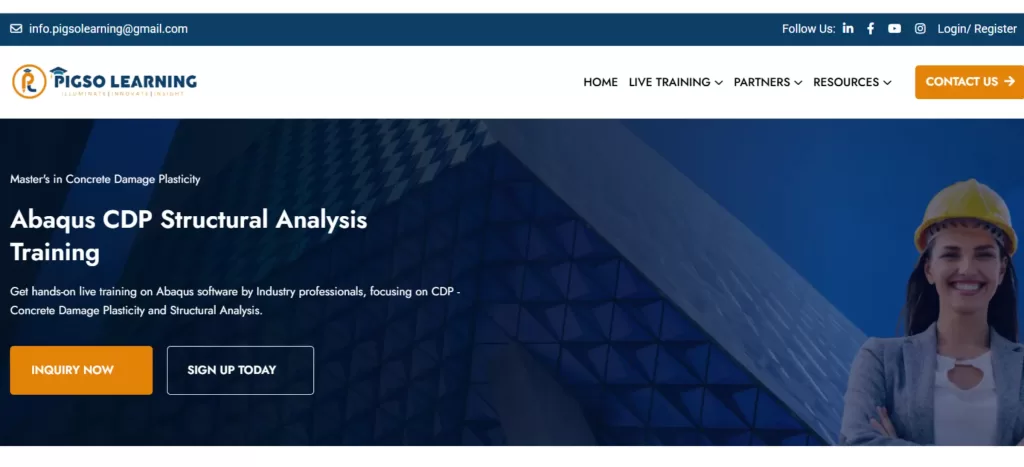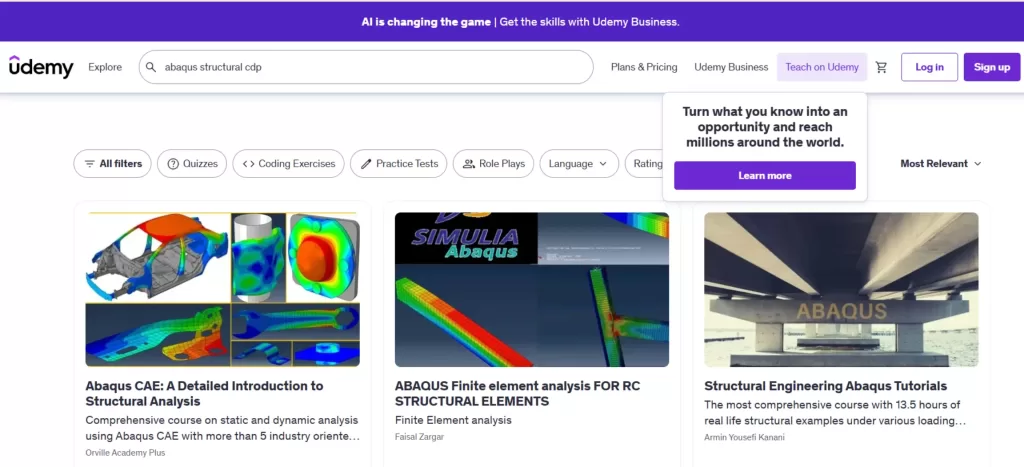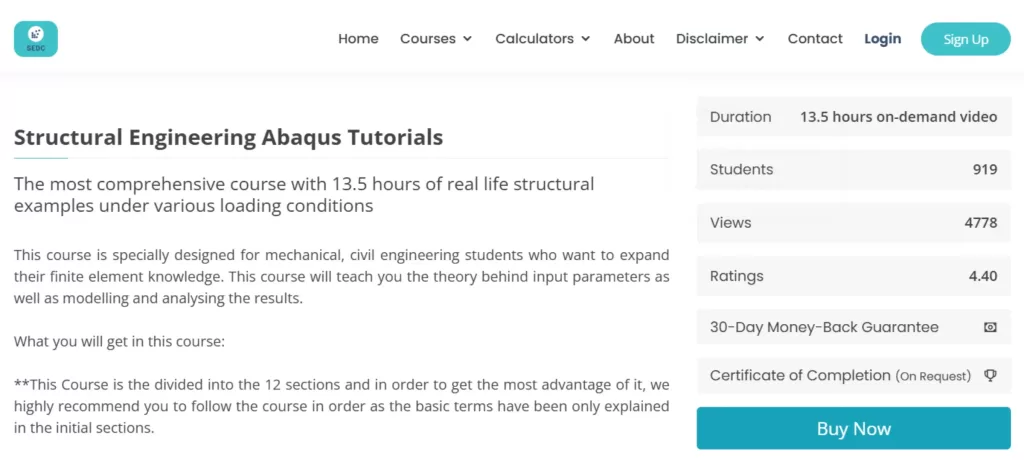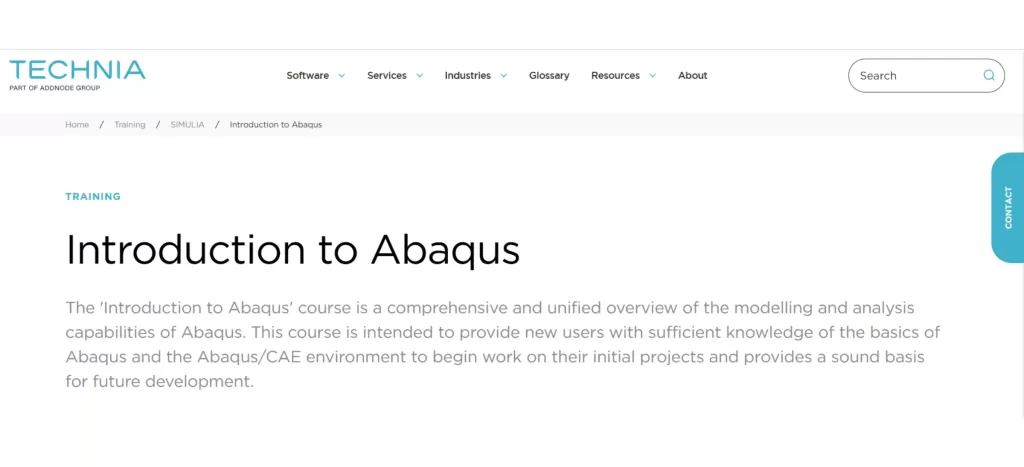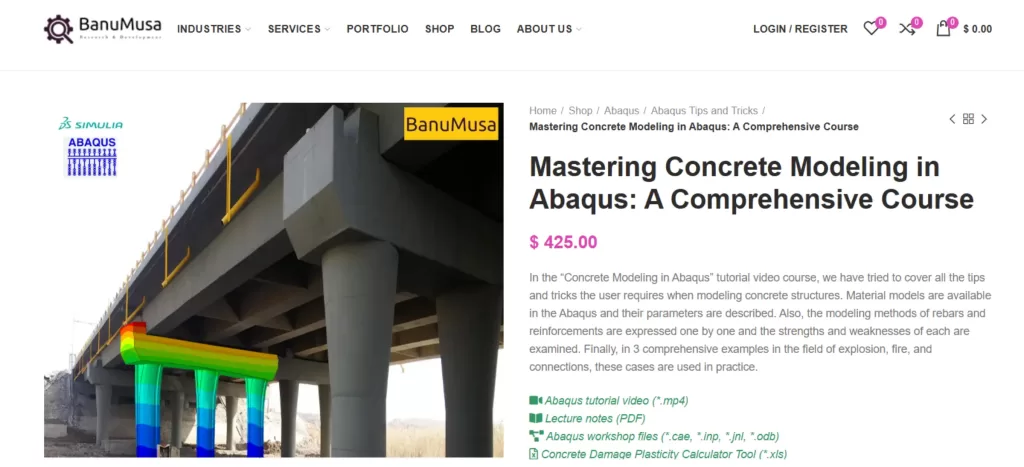It usually starts the same way: one messy concrete simulation, hours spent tweaking mesh sizes, and still no convergence. If you’ve worked with Abaqus structural software, you already know that it’s powerful but unforgiving.
And once you step into Abaqus CDP, things get trickier. Cracking, crushing, stiffness degradation, one wrong material setting, and everything falls apart. That’s why more engineers are turning to structured Abaqus tutorials that not only show clicks but also explain the reasoning behind each setup. Because of the winging CDP? It doesn’t end well.
And with the growing demand for concrete damage plasticity Abaqus modeling across civil structures, blast-resistant elements, and everything in between, knowing how to learn Abaqus software isn’t optional anymore. It’s survival.
Choosing Structural Engineering Abaqus Tutorials That Don’t Waste Time
Now, let’s be honest, there are plenty of Abaqus tutorials floating around the internet that claim to teach concrete damage plasticity, but a lot of them? They barely scratch the surface. You want more than button-clicking walkthroughs. You want modules that treat the Abaqus CDP model as a serious engineering challenge, not a weekend hobby.
That’s why this list doesn’t come from fluff or marketing banners; it’s curated from real feedback, real enrollments, and the real structural pain of nonlinear concrete modeling.
1. PIGSO Learning
This one feels personal. We built PIGSO LEARNING because most of us were once staring blankly at Abaqus CAE, trying to make sense of CDP tension stiffening curves and viscosity inputs that made no difference, or all the difference. Our course doesn’t just throw a tutorial video at you. We teach the why behind every parameter.
If you’re exploring mesh-dependent behaviors or tuning tensile damage parameters, we walk through it in live sessions and self-paced content.
Pros
- 1:1 mentorship and live doubt-solving support
- Hands-on project assignments
- An advanced certificate on completion
- One-year access to video content
- Industry expert with 6+ years of experience
- Networking opportunities
Cons
- Limited seats for better interaction
- Fixed schedule for live sessions
- Pricing shared after inquiry
- Civil/structural focus for targeted learning
Duration: 1.5 Months (25 hours)
Get more info: Click here
2. Udemy
Udemy provides hands-on Abaqus structural courses with a strong focus on Concrete Damage Plasticity (CDP). Learn nonlinear material behavior, reinforcement modeling, crack simulation with XFEM, and real-world loading cases like bending, impact, and cyclic loads. These hands-on tutorials are ideal for civil and mechanical engineers looking to apply CDP in beams, columns, and reinforced concrete structures.
Pros
- High rating, real structural focus
- Certificate of completion
- Lifetime access
- Downloadable resources and captions
Cons
- Limited interaction; no live support
- Lacks depth in some advanced topics
- Requires Abaqus basics
Duration: 9 to 22 hours (Depends on the course)
Get more info: Click here
3. SEDC Training – Civil-Focused Abaqus CDP Generator Use
SEDC keeps it tight and technical. Their Abaqus tutorial for civil engineering is built specifically for CDP users working on high-strain-rate and dynamic simulations. If you’re working with blast models or concrete confinement, this is worth considering. Their coverage of stress-strain curves for post-peak softening is sharp and avoids the usual academic fluff.
Pros
- Deep focus on CDP parameter tuning
- Self-paced and flexible
- 30-day refund policy
- Certificate available on request
Cons
- No live support
- Not beginner-friendly
- Suited for advanced CDP use only
Duration: 13.5 hours
Get more info: Click here
4. Technia – Enterprise-Level Abaqus Structural Software Training
Technia leans more toward organizations and enterprise clients, but if you’re on a team that needs scalable training on Abaqus for structural engineers, especially with reinforced concrete, this is where you’d go. They include simulations on slab panels, columns under eccentric loading, and CDP creep modeling.
Pros
- Expert trainer with industry experience
- Live, in-person sessions
- Certificate of attendance
- On-hand training coordinator
Cons
- Not ideal for individual learners
- Fixed schedule, less flexible
- Not suited for complete beginners
Duration: 4 Days (8 – 12 hours approx)
Get more info: Click here
5. Banumusagr – Niche CDP Tutorials for Reinforced Structures
This one’s kind of underground. Banumusagr’s tutorials have been picked up by engineers looking for guidance on concrete damage plasticity, Abaqus modeling involving seismic zones, and nonstandard reinforcement layouts. The language can be rough in places, but the case-based format hits the mark.
Pros
- Covers CDP, beams, slabs, and bridge models
- Includes notes, files, and CDP calculator tools
- 24/7 online mentoring support
- 15-day money-back guarantee
Cons
- The price is relatively high
- No live or interactive sessions
- Not beginner-friendly
- No formal support
Duration: (Not Mentioned)
Get more info: Click here
Final Thoughts
You can’t shortcut your way through the Abaqus CDP model. Anyone who’s tried knows it. What you need is not just a “course” but a roadmap, one backed by research like the 400 simulations study and the hard-won clarity that only structural analysis in the trenches can teach.
So if you’re tired of toggling between forum tabs and cryptic PDFs, maybe it’s time to join us at PIGSO LEARNING. We don’t promise magic. Just real learning from real engineers.
FAQs
1: How to learn Abaqus software?
Start with beginner tutorials that explain the basics clearly. Then move to advanced topics like CDP with real examples. Choose courses that explain both how and why.
2: What is the best way to start learning Abaqus for structural engineers?
Look for courses that teach the principles behind Abaqus CDP and CDP generators so you don’t get stuck tweaking defaults blindly.
3: Do I need prior experience in FEM to use Abaqus for civil engineering?
A basic knowledge of FEM is useful, but not required. Many structured tutorials—especially those covering Abaqus Concrete Damage Plasticity (CDP), are beginner-friendly when they include theory and calibration context. For a detailed guide, check out our blog: Abaqus for Civil Engineering.

Mayank Panchal is the founder of PIGSO Learning. He has many years of experience in teaching, curriculum development, and instructional designer in civil engineering, Mathematics, and digital marketing space. His passion for conceptual and deep research-based learning helps to understand the subject in depth.


